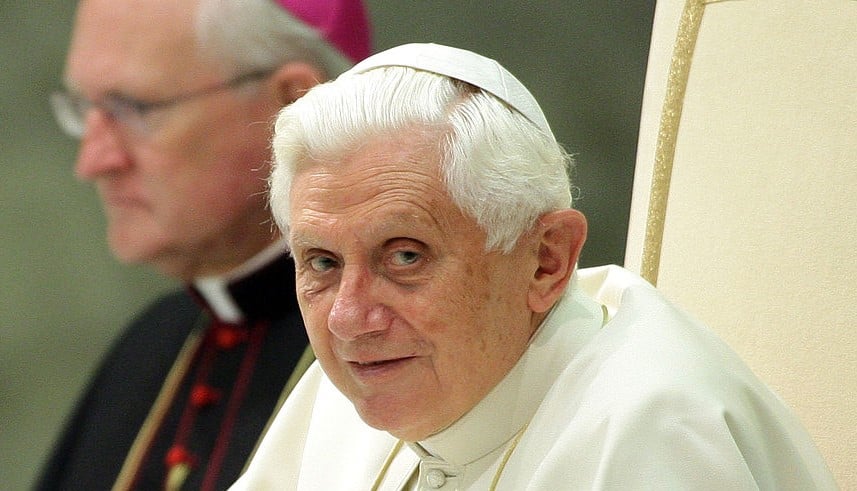What Benedict XVI meant to me and my sisters
I was in our community chapel, just before Mass, when I received a message that Pope Emeritus Benedict XVI had died. My immediate reaction was a whispered “thank you” to him, for we have so much to be grateful to him for. Without him and without Anglicanorum Coetibus, his Apostolic Constitution that made it possible for groups of Anglicans to enter into full communion with the Holy See, we might not be here at all. The post What Benedict XVI meant to me and my sisters appeared first on Catholic Herald.

I was in our community chapel, just before Mass, when I received a message that Pope Emeritus Benedict XVI had died. My immediate reaction was a whispered “thank you” to him, for we have so much to be grateful to him for. Without him and without Anglicanorum Coetibus, his Apostolic Constitution that made it possible for groups of Anglicans to enter into full communion with the Holy See, we might not be here at all.
We are now the Sisters of the Blessed Virgin Mary, but the community of which most of us were originally part was the Community of St Mary the Virgin. Founded at Wantage, then in Berkshire, in 1848, it is one of the oldest Anglican communities in the world. It was born out of the Oxford Movement: a movement of High Church Anglicans who sought to reclaim the Church of England’s Catholic inheritance.
We wore a traditional habit, sang our offices to Gregorian plainchant, spent time in adoration of the Blessed Sacrament and took solemn vows for life of poverty, chastity and obedience. Basically, we sought to replicate the practices of a traditional Catholic monastic community – except for the fact that we were Anglicans.
Most sisters had grown up in Anglican families and so when discerning a call to consecrated life naturally sought to live that out in the context of the Church of England. A former Archbishop of Canterbury once described the Church of England’s communities of professed Religious as its “best kept secret”, but that was a long time ago.
Religious life is meant to be countercultural, but it had been significantly watered down. In our own community it seemed that some of the treasures of monastic life had not been safeguarded. By the time that I was elected Mother Superior in 2006 we had reached the point where the community needed to be reformed at a deep spiritual level.
Although we had in Chapter meetings repeatedly agreed to continue as a traditional monastic community, some sisters were striking out on their own. They would not live by the Rule, wear the habit, or even live with others in community houses. They were in danger of exchanging their monastic vocation for a notion of a loose association of well-meaning women doing good works.
But that is not monastic consecrated life, and so a spiritual battle had begun for the heart and soul of our community. Step by step, spiritual ground was reclaimed during our last five or so years at Wantage. All sisters were recalled to the basic tenets of our common consecrated life: to live out the evangelical counsels in the context of monastic life. Some chose instead to leave the Community and be secularised.
Within the Anglican Communion there is no Vicar of Christ and no Magisterium. In the Church of England decisions which have profound theological implications are made by an elected synod, many of whose members have no theological or other appropriate training. Some aspects derived from the wider Church of England, and over which we had no control, impacted upon our community directly. Some sisters who sought a return to the authentic understanding of consecrated religious life looked to the Catholic Church.
Over the years, many sisters had felt called to become Catholics but the process was not straightforward. Each community has its own rules and regulations for accepting new members. For any of us to join a new Catholic community as a Religious, some communities required that the sister be released from her Anglican vows and community and start over again in the novitiate.
Most of the sisters were in their seventies and eighties, so this option was null. In any case other communities, for understandable reasons, did not feel able to commit to accepting elderly novices. For us, therefore, Pope Benedict’s invitation to come into full communion corporately, to have our existing years of Religious life recognised and affirmed, was a gift beyond all our dreams.
Exactly one year after our reception into the Church, the Sisters of the Blessed Virgin Mary were formally erected by Rome as an Institute of Consecrated Life. It has been a long and difficult journey, about which I have written elsewhere in the pages of the Catholic Herald. However, we shall be eternally grateful to Pope Benedict for his vision and generosity in erecting the Ordinariates and in enabling us to become Catholic nuns.
It seemed particularly fitting that on the exact tenth anniversary of our reception into the Church – the Solemnity of Mary, Mother of God – on the day after his death and at our first opportunity, we assisted at Mass in our chapel, celebrated by a priest of the Ordinariate of Our Lady of Walsingham, for the repose of the soul of Pope Benedict. We did so in thanksgiving and gratitude for this gentle and visionary shepherd who has been such an enormous part of our corporate and personal spiritual journeys.
Mother Winsome SBVM is superior of the Sisters of the Blessed Virgin Mary
Photo: Franco Origlia/Getty Images

The post What Benedict XVI meant to me and my sisters appeared first on Catholic Herald.














